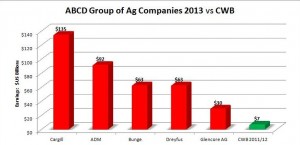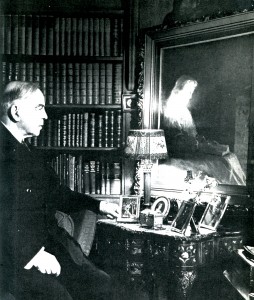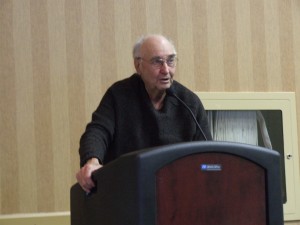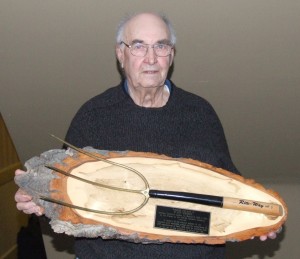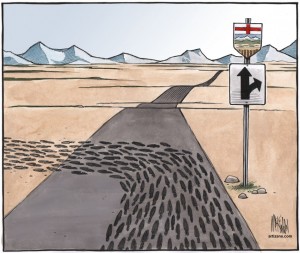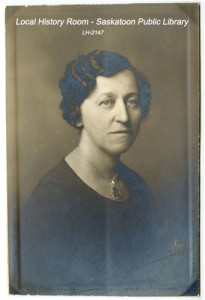Saskatchewan government peddling fairy dust – again
(August 11, 2016) With prospects of another bumper crop, the Saskatchewan government is laying the groundwork for a “blame the railways narrative” with its recent news release titled “Joint Efforts Ensure Grain Transportation System Is Prepared to Move Harvest.”
The Saskatchewan Government is pretending that setting up talking shops with no regulatory power will somehow move the giant grain handling companies to give up their profits for the benefit of farmers. The unbalanced approach of the Sask. government can be seen in their willingness to interfere in the collective bargaining rights of port workers while turning a blind eye to the defective market structure which allows the grain handling companies to arbitrarily choose how much they will pay farmers for their grain.
After the marketing debacle of 2013-14 the Harper Conservatives attempted to cover up the consequences of killing the logistical influence of the farmer-owned and controlled Canadian Wheat Board on grain marketing by painting the railways as the scapegoats for the mess. In fact it was the private grain handling companies that were taking excess profits from farmers during the bumper crop year of 2013-14 and blaming the railways.
However the Canadian Transportation Agency’s December 2014 determination of the Maximum Revenue Entitlement (MRE) – commonly known as the “rail cap”-, showed that narrative was false. In fact that bumper crop was moved very efficiently. The CTA reported that rail movement increased almost 19% that crop year in response to a crop about 25% above the previous year (see: Agriculture and Agri-Food Canada, July 22, 2014 Outlook for Principal Field Crops).
The Agi-Food report also noted “low carry in stocks” which is a nice way of saying that 6% difference between production and rail grain hauling increases filled a grain pipeline that had been emptied as a result of the US drought the previous year.
Without the single-desk Wheat Board farmers are no longer shippers and it was the grain handling companies, not the railways, who increased their basis charges to cover up their excess profits taken at the expense of farmers. It was the grain companies who were having trouble meeting customer needs through effective management of grain delivery to their port facilities. CWBA noted in November of 2013 that “Competition creates chaos at ports.”
Given current predictions, we can expect a repeat of that this coming crop year. And for much the same reasons, as was said here.
The railways are constrained by the MRE from over charging grain shippers for transportation. However, the grain shippers are now almost exclusively the private grain trade and usually they own both the inland elevators and port terminals. Due to the distances between inland elevators they are not effectively constrained from taking excess profits from farmers who are captive to them. A bumper crop and the associated propaganda from the Sask. government and the trade will not change this fact.
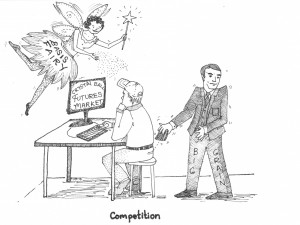 The government of Saskatchewan’s calls for greater transparency simply mask the fact the private grain trade is under no obligation to disclose port prices or the prices they are taking from customers around the world in any sort of timely fashion that would benefit prairie producers. Given the imbalance of market power between farmers and grain companies such transparency would make little difference at the farm gate in any event. Nor will it change the fact that without their single-desk Wheat Board farmers will once again watch world prices being diverted into the hands of the grain trade who now own the grain from the time it leaves the farmers’ trucks at the inland elevators.
The government of Saskatchewan’s calls for greater transparency simply mask the fact the private grain trade is under no obligation to disclose port prices or the prices they are taking from customers around the world in any sort of timely fashion that would benefit prairie producers. Given the imbalance of market power between farmers and grain companies such transparency would make little difference at the farm gate in any event. Nor will it change the fact that without their single-desk Wheat Board farmers will once again watch world prices being diverted into the hands of the grain trade who now own the grain from the time it leaves the farmers’ trucks at the inland elevators.
With yet another bumper crop in the offing, once again the ground is being laid to divert attention from the grain companies using their new found status as both the owners and shippers of wheat and barley for export to take more profits out of the system by using their market power to short change farmers.
How long does Thunder Bay have?
(August 3, 2016) Last week’s effective closure of the port of Churchill as a grain shipping port and likely a rail-based adventure tourist destination marks another sad milestone in the transformation of the western grain economy. In spite of assurances from the Western Grain Elevators Association (WGEA) that they have lots of handling capacity at Thunder Bay to offset the loss of Churchill; the closure darkens the future of Thunder Bay as well.
The WGEA say they represent companies handling “in excess of 90% of western Canada’s bulk grain exports.” But if you cut through the corporate jungle, aside from a handful of comparatively tiny Canadian companies their membership is really the foreign giants of the ABCD group that effectively run the rest of the world’s grain trade. By claiming that the real issue is handling capacity the WGEA is diverting attention away from both the killing of the Wheat Board being the primary cause of the closing of Churchill and the fact Churchill was a smaller competitor.
Of course it is true WGEA’s members have lots of handling capacity elsewhere and are building more. However it is also true that for those farmers in the Churchill catchment area the WGEA facilities cost more to use. Their next nearest port is Thunder Bay.
In light of the Western Grain Elevators Association assurances, it is fair to ask how long it will be before Thunder Bay suffers the same fate as the port of Churchill?
Like the OmniTrax terminal at Churchill, the Mission terminal at Thunder Bay is not really owned by the largest ABCD group members. Glencore’s Viterra terminal and the two Richardson terminals at Thunder Bay are also small players compared to the west coast ports or even the deep water ports along the St. Lawrence river.
So how soon will it be before the big players of the ABCD group choose to bypass another small competitor? After all closing just one or two of the larger Thunder Bay terminals would go a long way to making the remaining facilities too small to carry the costs of moving grain through the St. Lawrence Seaway system.
For the larger players with terminals on the St. Lawrence River at Baie Comeau, Port Cartier, and Quebec City, sending whatever grain is needed for the Atlantic market via rail to these deep water ports on the St. Lawrence River must be a tempting option especially since they can lower their fixed overhead costs by abandoning Thunder Bay and any extra operating costs will be paid by farmers.
The process of abandoning Canada’s long standing quality-assured grain export system with its focus on high-end niche markets around the world is pretty much complete. It started with the 2011 killing of the Canadian Wheat Board which ended the democratic influence of farmers on this system. Without the single-desk Wheat Board, the formerly Canadian controlled system is largely controlled by the same four giant companies (known as the “ABCD” group) that run the rest of the world’s grain production.
As was said here, the port of Churchill was all about providing value to the farmers in its catchment area of eastern Saskatchewan and Manitoba. However, without the Wheat Board, the system is absolutely not about producing value for farmers. Now the system is about profits for the ABCD group.
What’s clear is that the closing of Churchill is one of the many shoes that have dropped since Harper and company killed the Wheat Board and there are more to come. It would be no surprise if Thunder Bay was next.
Churchill tweets raise more questions
(August 1, 2016) When it comes to the announced abandonment of the port of Churchill former Harper Agriculture Minister Gerry Ritz is manfully tweeting and twittering in an effort to create doubt and divert attention from the corpse of the Wheat Board hanging around his neck. He does this whenever another wreck happens as a direct consequence of killing the farmer-owned and operated Canadian Wheat Board.
Churchill, Manitoba, is Canada’s most northern sea port. The rail line servicing it is a life line to the remote communities on its route and the port itself has great strategic value for Canada’s northern sovereignty. This is particularly true in an era of global warming where the Arctic Ocean may well become this century’s Mediterranean Sea – a common ocean bordered by different nations and traversed by ships from many others.
Lately, the former Agriculture Minister with the help of his followers has been tweeting away at great lengths about the poor state of the Churchill rail link, its low speed, and the limited storage capacity of the grain terminal.
These are mostly red herrings. When the Wheat Board was marketing grain it filled the terminal over the winter so the speed on the rail line was not such a big issue. Since the port is only ice free for a short period its storage capacity, which is the other excuse the former Minister and his supporters are trotting out, does not make much difference to the amount of grain that can be run through the port. But hey, when you’re trying to avoid taking responsibility for the consequences of your actions, any diversion will do.
But these excuses raise some interesting questions. For example, the former Minister says Ottawa offered the owners of the Churchill rail line matching dollars for upgrades. Yet this is something successive Conservative Agriculture and Transportation Ministers let slide during the ten years of their tenure. In a tweet the former Ag Minister gave a ball park estimate of the cost of line upgrades at $200 million.
So why would a profit-oriented private company leave $100 million in free money sitting on the table, especially in an era of near zero interest rates? And why would the Harper Conservatives let it all slide?
There are two obvious explanations which come to mind why OmniTrax management apparently left all that money on the table. One would be that neither the rail line nor the terminal capacity was causing significant problems when the Wheat Board was sending grain through Churchill to premium Atlantic markets – so there was no compelling reason to upgrade. The other could be that OmniTrax’s management no doubt understood that without the Wheat Board they had almost zero chance of their terminal being used by the giants of the international grain trade for servicing the international grain market.
Much to the annoyance of the international grain trade, the farmer-controlled Wheat Board was ruthless about choosing the port that would yield the best returns for farmers. Unlike all the other players in the international grain trade, the Wheat Board was only interested in getting prairie farmers the maximum value for their crop and within its limits Churchill filled the bill.
Either way, it looks like OmniTrax management made a good call since up till now we know the members of the international grain trade have chosen to go for the low hanging fruit of expanding their existing facilities and further narrowing the shipping options open to prairie farmers.
After all once Churchill is gone, the alternative routes for grain from Manitoba and Eastern Saskatchewan are through the trade’s facilities at Thunder Bay and down the St. Lawrence Seaway or directly by rail to their existing deep water terminals along the St. Lawrence River – or perhaps south into their US facilities. All the routes are more expensive for prairie farmers who end up paying the costs. However, those farmer-paid costs are just more profits for the giants Gerry Ritz gave marketing freedom to.
Churchill was about value for farmers
(July 28, 2016) It is never well received to say “we told you so” but the people of the Churchill, Manitoba region, this organization, and many others have long warned that killing the farmer-controlled, single-desk Canadian Wheat Board (CWB) would spell the end of the Port of Churchill and much else.
Some 95% of the grain going through Churchill was directed there by the single-desk CWB because Churchill provided significant value to wheat farmers in eastern Saskatchewan and western Manitoba for servicing Atlantic markets.
For those prairie farmers part of that significant value was reduced freight costs estimated in the range of $10 to $25 per tonne compared to the alternative route through the St. Lawrence system. Another part of that extra value came from premiums paid by customers which were returned to farmers through the Wheat Board.
Those higher values for farmers gave the CWB an incentive to fill the port of Churchill with grain over the winter at a very modest storage cost while running trains over the frozen rail bed thereby extending the life of the rail line itself.
There was enough extra value produced by Churchill that the CWB paid farmers for storing grain on their farms until the time when rail cars could be moved to Churchill in anticipation of its relatively short ice-free season – and with global warming that ice-free season may be longer in the future.
Churchill relied on a marketing system that was oriented towards returning maximum value to farmers and with the end of the single-desk Wheat Board that system was destroyed. In its place is a system owned and operated by four giant companies and one or two comparatively trivial-sized Canadian grain handlers.
None of those companies own the Churchill grain terminal and they have no doubt calculated that doing so makes no sense for them when they are building new handling facilities and already have surplus capacity at Vancouver, Prince Rupert, Thunder Bay, and along the St Lawrence River. There is no incentive for them to move grain through Churchill when they own their own facilities at other ports.
In contrast the Wheat Board never suffered from such a conflict of interest when it came to choosing among port facilities and so Churchill prospered because it offered value to farmers. Without the CWB, farmers are cut off from the world market just as the Port of Churchill is now cut off from export grain shipping.
Harper’s Agriculture Minister and the bureaucrats they put in place at Agriculture and Agri-Food Canada were shrewd enough to understand Churchill needed the single-desk so they put a $10 million subsidy in place to keep Churchill alive until after the last Federal Election. Perhaps they hoped people would not notice.
However, the voters of the Churchill basin saw though this shoddy and expensive bit of trickery and defeated a determined challenge by the Conservatives to take the seat from the NDP.
Canadians also saw though the destructive Harper Conservatives and threw them out of office in the last election. However it would appear the affable Liberal Agriculture Minister has yet to clean out the bureaucrats in his department who helped visit this entirely avoidable calamity on the workers in Churchill who depended on Wheat Board grain shipments and the farmers of western Canada.
Canada is losing an ocean port of strategic value to the nation and whose economic value to prairie farmers and port workers was destroyed by the Harper Conservatives when they killed the single-desk Wheat Board.
Prairie Arms Race
 (July 7, 2016) Prairie farmers may remember former Harper Ag Minister Ritz assuring us that killing the Wheat Board would mean grain shipments would flourish. Grain bin salesmen he said would be unhappy because without the Wheat Board grain shipments would go so quickly that farmers would no longer be interested in storing grain on their farms.
(July 7, 2016) Prairie farmers may remember former Harper Ag Minister Ritz assuring us that killing the Wheat Board would mean grain shipments would flourish. Grain bin salesmen he said would be unhappy because without the Wheat Board grain shipments would go so quickly that farmers would no longer be interested in storing grain on their farms.
The exact opposite has happened. There is now a grain storage arms race on the prairies. On the one side farmers are expanding their own on-farm storage capacity and on the other the grain handling companies are building up their inland storage capacity. The only catch is that prairie grain farmers will be paying for it all, either directly out of their own pockets or in the form of lower grain cheques as the private companies recoup their investments.
So why an arms race in grain storage? The private grain handlers would like everyone to believe it is the fault of the railways for not responding to their orders on time. However we know from the data of the December 18, 2014 Canadian Transportation Agency decision on the Western Grain Revenue Entitlement, which deals with grain movement, that this idea might be politely described as “businessman’s puffery.”
A more fundamental reason for this goes back to a defect in grain and food markets which even Socrates noted some 2,300 years ago: when there is a good harvest, grain is worth almost nothing in the market and yet scant months later, its value jumps. Both market prices are irrational.
The political-economist David Ricardo characterized irrationally low post-harvest prices with the term “elasticity of prices” by explaining that “peoples’ bellies are not elastic” and consequently they will pay little or nothing for food once their stomachs are full.
So the arms race in storage is really yet another manifestation of this old wisdom. Grain companies know that post-harvest farmers, especially younger ones, have bills to pay which presents the companies with a fine opportunity to purchase grain at a discount then dribble it onto the market later when prices are higher. This is also why well-established farmers now want to hold grain in on farm storage.
On my last trip from Alberta down Saskatchewan’s highway 14 to Saskatoon I was struck with all the new bin space farmers along that road have built in the last few years. These are not just a few hopper bins on skids – a lot of them are very large steel bins on concrete worthy of grain elevators from the past. Even the cautious Parish and Heimbecker has seen fit to expand one of their terminals with what appears to be a large circus tent adjacent to their more substantial inland terminal.
All of this construction is designed, in one way or another, to take advantage of a defective food market. Farmers are seeking to avoid being the victims of speculators and the grain companies are seeking to be speculators.
This defective market was addressed by the Saskatchewan farm leader Ed Partridge in the 1910s when he suggested price pooling and a single-desk seller for grain. He did not live to see prairie farmers successfully implement the ideas of price pooling and the long success of the single-desk farmer controlled Canadian Wheat Board.
Nor did he live to see its destruction by the Harper Conservatives and their less than thoughtful agriculture Ministers.
The prairie arms race in grain storage has once again shown that the simple nostrums of the Harper era were the product of short-sighted thinking and a basic innocence about commodity markets at best or vicious greed and stupidity at worst. Whatever the reason, prairie farmers will pay for it all.
###
Ps: When I was browsing in the independent book store McNally Robinson in Saskatoon I noticed a book launch featuring a local musician, B.D. Willoughby, and one of the songs on his new album is called “The Ballad of Ed Partridge.” It’s a good summary of what Ed Partridge stood for.
Farewell Harper
(May 26, 2016) This weekend the Conservative Party will hold its policy conference in Vancouver and Stephan Harper will give his swan song and by all reports resign his seat in the House of Commons ending the career of one of the odder politicians Canada has seen since the séance-attending Mackenzie King communed with the spirit of his dead dog over 75 years ago.
For farmers Mr. Harper first appeared as the head of the National Citizens Coalition when he fronted for a very well-funded attack on the integrity of the election process for Directors of the Canadian Wheat Board. The NCC and its backers wanted to make the process subject to big money donations and other less than savory electoral practices the likes of which later landed some of Mr. Harper’s colleagues in jail.
Harper even attended a meeting in Red Deer, Alberta arranged by the industry captured Alberta Agriculture to drum up support for his dubious notions about the Wheat Board. None of us knew at the time his dead-eyed stare and immobile face would become the trademark of a future Prime Minister. At the time I attributed his reaction to the fact most of the crowd of over 100 farmers was not very enthusiastic about having their business interfered with by a callow ideologue who obviously knew little about the business and even less about international grain marketing.
However, once entrusted with a majority government Prime Minister Harper wasted no time in destroying the Canadian Wheat Board. To his credit, he poured huge sums of tax money into making his fantasy dual market work – until the money and credit ran out. Then his administration gave the remains to the Saudi Arabian Government and Bunge, one of the international giants the CWB was created to compete with.
The new Liberal administration in Ottawa is busily dismantling the many loony policies put in place by what in retrospect looks like a resentful and alienated group of teenage vandals.
However what can never be forgiven or un-done from the Harper years is the systematic destruction of Federal Research libraries including the libraries of the Agriculture Canada Research farms and field stations.
A little refresher. Those libraries contained scientific monographs about all things Canadian in agriculture, health, and natural history dating back to the 1800s. Each piece of scientific work represented, in some cases, the whole life’s work of a scientist, plant breeder, naturalist, or explorer. Many were so rare that only one or two copies existed in the whole world.
The Harper Conservatives always followed the same methodology. First they would cut the staff who consulted those libraries. Then they would fire the librarians who managed the collections. Once the librarians were gone, the remaining staff were told to salvage what they needed for their current research.
This made the collection completely chaotic and the only people who had the training and ability to manage it, the librarians, were long gone along with any budget to computerize the collections. The Harper Conservatives then gave the order to put the libraries in the dumpster. This is exactly what happened to 16 Federal Research libraries, 9 Agriculture and Agri-Food Canada research stations, the Health Canada Library, the Freshwater Research Library at the University of Manitoba, the Canadian Wheat Board Archives and Library, and others.
So that scientific work has been irreparably lost and the lives of those generations of researchers who provided base line information for us and future generations have been wasted.
There are some things the Harper Conservatives have done which are easy to change. Respect for knowledge and evidence, farmer market power through collective bargaining, respect for the rule of law and the courts, ignoring or not signing abusive and undemocratic trade agreements all come to mind. But what can never be undone is the destruction of priceless knowledge forever lost and the waste of lives that represents.
It will also take a long time to put the genie of hatred, fear, doubt, and distrust loosed by the Harper Conservatives back into that dark place it belongs. As in post-war Germany, it will take a long time to rehabilitate the Conservative name and allow Conservatives a place in the civilized discourse of democracy simply because no decent person, understanding the implication of the great Canadian book burning can ever support Harper style Conservatives again.
Whatever Harper’s reasons for retiring now the Conservative policy convention this weekend in Vancouver has a delicate balancing act to perform. On the one hand it needs to pay tribute to an odd and introverted man who dedicated his life to obtaining power for his decidedly un-conservative brand of Conservativism. However respecting Stephen Harper’s single-minded dedication to that goal (his Herculean effort to master the French language in record time comes to mind) has to be balanced with a clear repudiation of the anti-intellectual book burners, bigots, and mountebanks that dominate the party Harper brought to power.
A Prairie Sentinel Falls
(May 20, 2016) It may well be a universal human affliction to suffer from “home blindness.” Many of us seem to think the wonderful places and great people are somewhere else.
Occasionally, however, the passing of someone reminds us that powerful individuals who will take their place in the history books for great deeds and great hearts also live here in western Canada. Certainly the news that Roy Atkinson, farmer activist and the founding President of the National Farmers Union passed away a few days ago in Saskatoon marks just such a milestone.
I first met the legendary Roy Atkinson in 1976 when I was an undergraduate at the University of Alberta. Even then he was a larger than life figure. As a farm activist he championed the institutions which made it possible for many farming families to send their children through higher education.
At that time Roy was making the rounds with Les Benjamin, the NDP transportation critic, talking about that perennial western subject: rail transportation. Roy warned us that changes to the Crow Rate would mean the farmer-owned grain handling cooperatives known as the Wheat Pools, which owned almost 90% of the grain elevators on the prairies would be forced to close most of their facilities and engage in a ruinous effort to centralize thousands of “prairie sentinels” into a few inland terminals. It would, he told us, create huge hauling distances for farmers and ultimately undermine the single-desk selling system.
To this writer’s eternal shame, I scoffed at the whole notion. Farmers, I thought, would not let their cooperative grain handling system be destroyed, let alone give up the market power they had achieved using the single-desk Canadian Wheat Board. As events have shown, Roy knew better. In 1976 there were a little over 3,900 primary elevators on the prairies, and now almost exactly as Roy predicted, there are a mere 327 licensed primary elevators left.
Some decades later I well remember Roy at the founding convention of the Canadian Wheat Board Alliance reminding us, while holding up a pitch-fork on a plaque (text below), that the only thing any politician understands is public pressure and the expectation of a more or less figurative pitch fork in the behind at the next election if they do not pursue the policies we want.
Roy’s death marks the end of an era in western politics where farmers were able to command government attention though their numbers. Roy foresaw the dangers of commodity specific check-off groups fragmenting and thereby limiting the political power of farmers. He strongly supported groups like the National Farmers’ Union that spoke for the common interests of farmers across the country.
It is often said that the first generation of a family builds the wealth, the second generation consolidates it and the third generation fiddles it away. As the current generation of western farmers comes to the realization that the institutions which enabled them to create their wealth are no longer there, the work of the next generation will be to follow in Roy’s not inconsiderable footsteps, and rebuild that single, independent farm voice.
I would recommend reading this tribute from NFU members who worked closely with Roy over the years and we reprint Roy’s complete obituary as it appeared in the Saskatoon Star Phoenix here:
The pitchfork plaque reads:
Presented with pride to R. Roy Atkinson, Advisory Committee member for District 6, 1965 to1994 by his friends on the 1991-94 Advisory Committee in memory of his staunch defense of the Canadian grain marketing system and the presentation to CWB commissioners in April 1970 when he instructed them in the use of this pitchfork to defend the CWB.
Alberta cleaning house
ALMA first to go
(April 28, 2016) The recently tabled Alberta budget contained some pleasant surprises for farmers and some cost savings for a government dealing with falling oil prices that have exposed almost 40 years of financial incompetence by its predecessors.
In keeping with Premier Notley’s undertaking that appointed boards and commissions will be reviewed, the first steps were implemented with the budget.
Several destructive and ideological based commissions were discontinued, their appointed Boards dismissed, and staff redeployed to what one hopes are more positive pursuits.
The most notable elimination is the Alberta Livestock and Meat Agency (ALMA). This agency boasted a budget of $28 million a year and a staff of 25.
ALMA was one of the of the three institutions, along with Alberta Agriculture and the Government’s Ag Financial Services that put together Alberta’s grandiosely titled “Alberta Livestock and Meat Strategy.” This document was a cowboy welfare wet dream – however, for export oriented grain farmers and Alberta’s cow/calf producers it was more of a nightmare.
In one of its later reports ALMA and company identified eliminating the Canadian Wheat Board as a method to reduce costs to cattle feeders. The same report also identified eliminating Kernel Visual Distinguishability (KVD), which was a very effective and cheap way to identify grain varieties as another way to lower animal feeding costs. As we now understand, the Harper government’s adoption of both these measures came at the expense of prairie grain producers.
Absurdly the organization also funneled money into something they called “Lean Manufacturing” to research automation technology for the meat packers. Given there are only two firms (Cargill and JBS) that process some 90% of Canada’s beef, this thoughtful gift from Alberta taxpayers and ranchers to two of the world’s largest companies must have come as a pleasant surprise to them.
The Alberta strategy also included other measures to “focus on the development of high yielding varieties” and the establishment of an “Alberta Feed Grains Center of Excellence.” High yielding varieties are already being more than adequately addressed by the Western Grains Research Foundation and a quick Google search for the Center of Excellence shows it was apparently more vapor-ware than real.
However, the money wasted by this organization was very real and the damage it has done to Canada’ reputation for high quality export grain and beef cannot be denied. The announcement by Earls Restaurants that they had given up their three and a half year effort to source enough certified antibiotic and growth hormone free beef from Alberta for their restaurants demonstrates the wisdom of eliminating ALMA and reviewing the collection of agricultural boards and commissions that collect tens of millions of dollars from Alberta’s farmers and ranchers each year.
International Women’s Day 2016
On March 8th we celebrate International Women’s Day. It reminds this writer of how important women have been to agriculture on the prairies and the pivotal leadership role they played in establishing modern Canada.
Creating grain farms on the prairies was hard work and for the most successful settlers it was a team effort that relied on women and men working equally hard though not always at the same jobs. Take for example the massive threshing crews whose work to bring in the grain at the harvest is so often highlighted at summer fairs across the prairies at places like the Birch Hills Threshing & Family Fun Day in Saskatchewan or Pioneer Days in Steinbach, Manitoba.
While it was mostly male crews that tossed the bundles into the thresher it was the women who made sure that the crews were fed and as often as not played a key role in organizing the farming operation and doing field and yard work during the rest of year as well.
International Women’s Day is a good day to recognize prairie farm women not only worked hard on the farm but organized and worked equally hard to extend democracy and social and economic justice. It was the Saskatchewan farm women who supported one of the very first attempts at Medicare in Canada.
One of their leaders was Violet McNaughton, who farmed with her husband, near Harris, Saskatchewan. They were both members of their local Grain Growers Association, one of many farm organizations dedicated to securing economic justice for grain growers. This is an organization where women took an equal role before the province of Saskatchewan would give them the vote.
Violet McNaughton, with the support of the Saskatchewan Grain Growers, was one of the women who organized petitions and campaigned for Saskatchewan women to get the right to vote. Some historians contend that McNaughton was such a formidable organizer and intellectual force that in fact it was the Grain Growers Association that had the support of Violet McNaughton!
With the help of the equally formidable Manitoban Frances Beynon, who campaigned for women’s suffrage in her own province, was an anti-war activist, and the women’s editor for the Grain Grower’s Guide paper, McNaughton organized the Women Grain Growers Association which drew its membership from farm women across Saskatchewan. The Saskatchewan Grain Growers gave this organization $500 in start-up money – about $10,000 in today’s money. When it came to supporting women’s equality they put their money where their mouth was.
Together Beynon and McNaughton joined other farm women from across the prairies to support the Famous Five who finally ended the abomination of relegating women to the legal status of horses and other chattels.
Farm women and men often had extremely limited access to health care including doctors and midwives. McNaughton campaigned for accessible medical aid and argued governments should pay for that health care. McNaughton and the Women Grain Growers got both the Saskatchewan Grain Growers and the Saskatchewan Association of Rural Municipalities to pass motions supporting their campaign for medical aid. With this support for their campaign it forced the provincial government to pass legislation that let municipalities enact taxes to cover medical aid costs. Municipally funded nurses, doctors, and hospitals were the beginnings of the foundations of Medicare.
In spite of the fact contraception and birth control was illegal at the time, McNaughton and her supporters, also promoted “family planning.” This contributed to our contemporary, although still controversial in some quarters, understanding that women have the basic human right to control their own reproductive system.
So on International Women’s Day we should remember and applaud Violet McNaughton, Frances Beynon and their fellow farm women who began the campaign – strongly supported by the grain farmers of western Canada – to build the social and economic justice that would ultimately lead to so much that defines Canada today.
You can read previous International Women’s Day posts on this site from 2012, and 2013, and 2014.
For your viewing pleasure
(February 29, 2016) Just in case readers are tired of the Oscars, for those of you with high-speed internet connections here is an interesting video – a 7 minute interview from December of 2014 with Dr. James Nolan, an agricultural economist with the University of Saskatchewan. In it he talks about the so-called grain transportation mess. Sounds very dry but for grain farmers it would easily qualify as a horror movie.
Not that Dr. Nolan is very scary, but what he says certainly is if you are a prairie grain farmer. In a very careful academic explanation, he says that without the CWB we are now getting around 40 to 60% of the grain cheque and the grain handling companies are taking the rest. Near the end he says his economic models show that as grain companies eat each other up we can expect to get about 20%. Yikes!
Dr. Nolan did this interview shortly after we published our finding “Grain Companies Take Excess Profits” which you can read by clicking here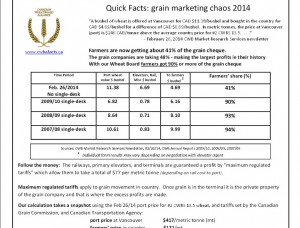
Later Dr. Richard Gray, also a University of Saskatchewan Agricultural Economist published a long paper detailing the same thing which you can download by clicking here
Basically Dr. Gray says we could have been $3.25 billion better off each year if we had kept the single-desk. Given the last year of operation of the farmer-controlled single-desk Wheat Board generated a little over $7 billion in sales, Dr. Gray’s findings show the grain companies are taking about fifty percent of the grain cheque. Now farmers are only getting around 40%, which is quite a come down from the 80 to 90% they were accustomed to on wheat and barley marketed by the Wheat Board.
As one reader said to me on this subject, “most farmers now get it that 90% of any given number with the Wheat Board is better than 40% without it.”
The Oscars always provide a gift bag to guests so with that in mind here is a thoughtful gift from Minister Ritz to some of his more dedicated followers which you can see by clicking on this link:
News has it this organization will be holding its annual convention in New Orleans, Louisiana this year: our tax dollars at work once again.
Lastly, a 14 minute video produced by the Canadian Wheat Board about 1990 or so which explains the history and operation of the Board in a dry but factual way. All steak with very little sizzle as the marketers would say.



